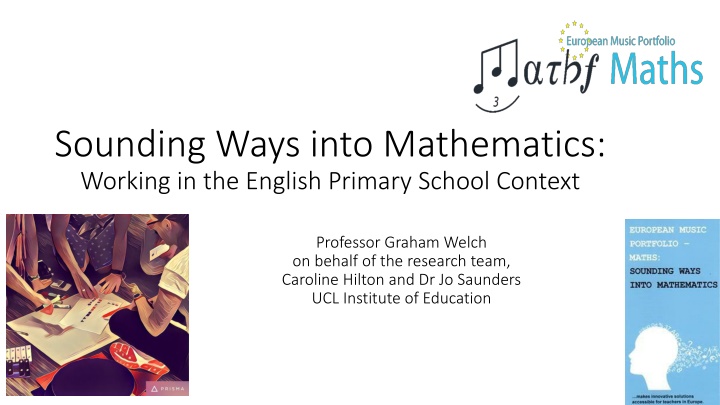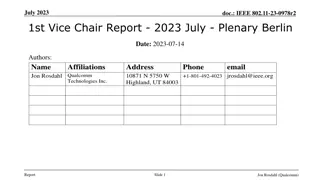Integrating Music and Mathematics in English Primary Schools
Exploring the connections between music and mathematics in primary education reveals enhanced learning opportunities and greater inclusion for students with diverse needs. Integration of music activities with mathematical concepts not only enriches the learning experience but also provides alternative avenues for expression and comprehension, benefiting students across different age groups and learning styles.
Download Presentation

Please find below an Image/Link to download the presentation.
The content on the website is provided AS IS for your information and personal use only. It may not be sold, licensed, or shared on other websites without obtaining consent from the author.If you encounter any issues during the download, it is possible that the publisher has removed the file from their server.
You are allowed to download the files provided on this website for personal or commercial use, subject to the condition that they are used lawfully. All files are the property of their respective owners.
The content on the website is provided AS IS for your information and personal use only. It may not be sold, licensed, or shared on other websites without obtaining consent from the author.
E N D
Presentation Transcript
Sounding Ways into Mathematics: Working in the English Primary School Context Professor Graham Welch on behalf of the research team, Caroline Hilton and Dr Jo Saunders UCL Institute of Education
Music and maths both use patterns and structures such as progression and symmetry According to Marcus du Sautoy: Rhythm depends on arithmetic, harmony draws from basic numerical relationships, and the development of musical themes reflects the world of symmetry and geometry . The project has sought to explore some of these ideas in our learning and teaching.
Models of Integration Barnes (2015) identified at least five common and contrasting ways of using more than one subject to respond to a problem, theme or issue. These styles of cross-curricular teaching and learning have different aims, depend upon a range of planning strategies and result in different learning opportunities: Tokenistic Hierarchical Multidisciplinary Interdisciplinary Opportunistic
Experiences of integrated music and mathematics activities (School 1, Year 3 pupils) Observations of integrated music and mathematical learning and teaching activities revealed greater opportunities for inclusion for those pupils who may otherwise have struggled to engage with mathematical learning 3 children with special educational needs, who usually receive 1:1 support from a classroom assistant, were able to participate independently The language barriers which were often a problem for children with English as an additional language, were less problematic when the children had another way of expressing their thinking
Experiences of integrated music and mathematics activities (School 2, Year 5 pupils) Observations of these learning and teaching activities revealed greater opportunities for a range of learning styles (as well as some challenges). Children had little experience of music and inititially found it hard to keep a rhythm going Issues linked to multiplicative relationships were represented through musical activity and provided the children with a meaningful context within which to discuss the issues raised The introduction of musical instruments added another dimension and made it easier to see and hear the musical/mathemtical patterns
Primary teachers in England: Investigating transformations through Music and Maths Primary teachers (from early years, special educational needs and mainstream primary settings) created graphic scores with 3D shapes. The musical material was manipulated using transformations and the compositions performed. The symbolisation represented pitch, rhythm, dynamic and duration amongst other musical elements.
Primary teachers in England: reflecting on the first day of the National Workshop Sixteen teachers took part in the first of two day-long national workshops. An evaluation was completed at the close of the workshop. Participants responded to a series of statements using a 7 point Likert scale. Teachers positively engaged with the activities and were given opportunities to talk through how to adapt the tasks to the particular needs of their pupils. The teachers reported that they felt more confident to approach these activities within their classrooms and that their knowledge about how to approach Music and Mathematics in an integrated approach had increased.
Primary teachers in England: reflecting on using Music and Maths in the classroom Following the first workshop, teachers experimented with the activities in their own classrooms. During the second workshop, they shared their experiences and further learning. Greater awareness of where the Maths is in an activity, for example explicit use of patterns to support a composition activity, or using number lines and prediction to create polyphonic rhythms Reflecting upon current practice and better of understanding how integrated Music and Maths can be used to include those pupils who are often excluded Gaining a shared language that begins to bridge the musical and mathematical learning in the curriculum Working more closely with colleagues with different strengths to plan and deliver interdisciplinary activities.
Sounding Ways into Mathematics: Working in the English Primary School Context Professor Graham Welch on behalf of the research team Caroline Hilton caroline.hilton.14@ucl.ac.uk and Dr Jo Saunders jo.saunders@ucl.ac.uk UCL Institute of Education























